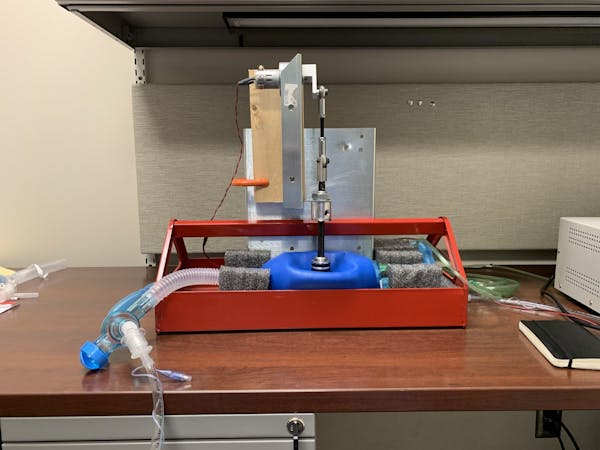The U.S. Food and Drug Administration has authorized production of a simple, low-cost medical device designed at the University of Minnesota to mechanically inflate the lungs of patients suffering significant breathing problems for COVID-19.
The emergency-use device, called the Coventor, was designed in temporary working digs in a conference room at the U. It was conceived to sell for as little money as possible. And it would not exist without donations and collaboration involving private companies that don't normally work on the same team.
One of the most remarkable aspects of the Coventor is its timeline — in the space of 30 days (and nights), the device went from an early demo using an old toolbox as a component to an FDA-authorized device moving into professional production to potentially save scores of lives.
"30 days! It was 30 days from the toolbox to FDA authorization. That is incredible," said Arthur Erdman, director of the U's Earl E. Bakken Medical Devices Center.
The first unit will roll off a Boston Scientific assembly line in Maple Grove in another month or so. Randy Schiestl, vice president of research and development at Boston Scientific, said Wednesday that only 18 days passed between when the company got involved and when the FDA approved its joint authorization request with the U.
"We've looked at several devices. This is the one that we thought we could get to market the quickest," Schiestl said. The speed to market "demonstrates the collaboration of all parties under emergency-use authorization to move quickly and agilely."
Medtronic, the medical device company cofounded by Bakken in Minneapolis 71 years ago, also provided input on the product.
COVID-19 is a respiratory disease caused by a novel coronavirus discovered late last year in China. In severe cases, people with COVID-19 develop acute respiratory distress and can't breathe adequately because of fluid buildup in the lungs.
The invasive medical devices have been the focus of worldwide attention because of fears that there will not be enough of the machines available when the number of critically ill COVID-19 patients reaches its peak.
The Coventor is not designed to solve the global shortage of ventilators — in fact, it is barely in the same category as the devices. It lacks alarm bells, it doesn't measure oxygen in the patient's blood and it relies on a commercially available ambulatory ventilation bag to work.
But what the Coventor does do is reliably pump air into a person's lungs, without requiring a family member or health care provider to sit at the bedside and manually pump the ventilation bag.
The device was first dreamed up by U cardiac anesthesiology fellow Stephen Richardson. He was thinking of a mass-casualty contingency developed for a similar respiratory illness in the past that included a plan to fill a large room with critically ill patients who needed to have family members or clinicians manually pump cardiac-resuscitation bags to keep their lungs moving.
All of those people could be using a Coventor, if such a scenario unfolded during the COVID-19 pandemic: The device has been described in some circles as a "one-armed robot" that pumps the resuscitation bag.
"We wanted to provide an option where, if it comes to that, you don't have to sit there and have somebody ventilate a patient by hand," said Aaron Tucker, the lab supervisor at the Bakken Center whose team worked with Richardson to develop the device.
Because of the low cost and ease of construction, the devices might prove useful in parts of the world where advanced medical care is difficult or impossible to get in an emergency. It could also be used in ambulances and as a backup device in a hospital setting.
Once Boston Scientific produces the first run of Coventors, the plans will be made available online, with no royalties due.
The project website said the system consists of a frame and a moving component that compresses an ambulatory ventilation bag that is connected to the patient's endotracheal tube.
The frame can be metal-stamped, 3-D printed, made from "modified consumer goods."
The device can be attached to external compressed oxygen or it can use ambient air.
Companies that provided financial or in-kind support for the device include Digi-Key in Thief River Falls, Minn.; MGC Diagnostics in Vadnais Heights; Protolabs in Maple Plain and Teknic in Victor, N.Y.

Want to share info with the Star Tribune? How to do it securely

'Safe recovery sites' would offer syringes, naloxone and more to people using drugs. The plan could be in peril.
New Minnesota GOP leaders seek peace with party's anti-establishment wing

Who is Republican Lisa Demuth, Minnesota's first House speaker of color?

